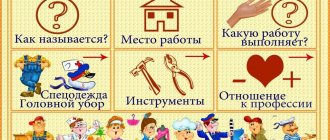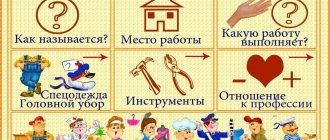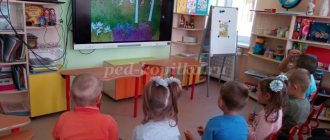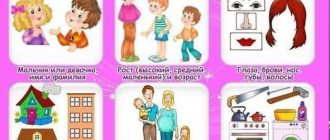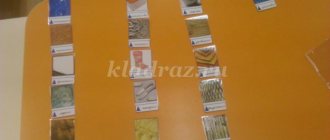Speech therapy tales and tongue twisters
Clear pronunciation of sounds is closely related to good diction. Many children of senior preschool age have problems with diction. Speech is often slurred and unclear. The reason for this is sluggish movements of the lips, unenergetic movements of the tongue. The lower jaw is inactive. Due to the fact that the mouth does not open enough, the vowels sound unclear.
All these speech-motor system defects can be corrected with the help of sound combination games. This is easier to do with younger children. For preschoolers with sedentary lips, the learning process is much more difficult. The speech therapist, showing how to pronounce sounds, makes clear movements with his mouth and slightly extends the vowels.
Speech therapy tongue twisters for children 6-7 years old
To improve diction, tongue twisters are used. First, the new tongue twister is pronounced slowly, clearly, highlighting significant sounds. The speech therapist should read it several times, quietly, rhythmically, without sudden changes in intonation. Then the child must try to repeat the tongue twister himself. Slowly and clearly at first, and then speed up the pace over time.
To make it more interesting for children to memorize tongue twisters, they should be funny and amusing. Here are some examples for working out the most problematic sounds:
For children 5-6 years old, you can also use tongue twisters as a method of correcting diction.
Examples of tongue twisters for correcting the pronunciation of specific sounds can be found in the works of Konovalenko V.V., Konovalenko S.V., Zhukova N.S., Kulikovskaya T.A.
The more interesting and understandable the tongue twister, the better and faster the baby will remember it. Parents can independently speak tongue twisters with their child on the way to kindergarten. 5-7 minutes a day will ultimately give noticeable results.
Explanatory and other types of speech as the level of development of a preschooler
Speech therapy tales for speech development
All children love fairy tales. Through fairy tales they learn about the world, the difference between good and evil. With the help of fairy tales, imagination develops and emotions awaken. Logo fairy tales are another entertaining method of working with children with special needs and correcting various speech disorders in preschool children. Thanks to this approach, children perceive learning as a game, they absorb information better.
Important! Children develop emotionally, thanks to communication with a fairy tale, the development of children's speech in monologues and dialogues increases. In addition, children become familiar with the beauty of the artistic word, and a healthy educational atmosphere is created.
A speech therapy lesson in the form of a fairy tale can be carried out in several stages:
- The plot of the fairy tale is comprehended. Children learn new expressions and speech turns. By intonation they must guess the mood of the heroes of the fairy tale. The development of the articulatory apparatus occurs due to the intonation of the characters’ voices, the use of onomatopoeic words, and animal voices.
- Teaching children to regulate emotions using verbal descriptions. Children retell their favorite episodes. Describe their attitude to certain events in the fairy tale. At this time, the speech therapist monitors the completeness and correctness of the sentences.
- The speech therapist invites the children to act out an episode from a fairy tale. The purpose of this task is to teach verbal improvisation, to convey an affective state through facial expressions and words.
The speech therapy teacher can play out speech therapy fairy tales independently in the classroom. Or you can take ready-made ones. Savchenko S. F. and Petrova E. A have a whole series of logo fairy tales. For example, the fairy tale “Teremok” is an excellent guide for children with speech and intellectual development disorders of varying degrees.
You can also perform articulation gymnastics in the form of a fairy tale. There are a lot of fairy tales about the tongue on the Internet, here is an example of one of them:
During classes, based on materials from fairy tales, exercises are practiced to develop the voice, attention, and speech breathing. For greater clarity, toys, pictures, and costumes are used. After the lesson, children can draw a picture on the theme of the logo tale they have just worked on. Children can also be encouraged to tell the story to their parents at home.
Self-analysis of speech therapy classes in preschool educational institutions
Self-analysis of speech therapy classes is an important element in the work of a teacher. This is the main way to improve your skills. The quality of self-analysis depends on the critical attitude of the speech therapist to his classes, on the habit of reflecting on his actions.
Criteria and assessments of speech therapy classes
When conducting a self-analysis of a speech therapy session at school or kindergarten, the speech therapist must answer the following questions:
- What is the motivation for selecting material for a particular lesson?
- Describe the group as a whole
- Do the objectives of the lesson coincide with the planned plan?
- What is the psychological assessment of the tasks that children performed in class?
- What is the pedagogy of the exercises performed
- Describe your overall satisfaction with the activity
- Evaluate the results and outline measures to eliminate deficiencies
Important! Self-esteem is a condition for the creative work of a speech therapist teacher. A technological map for self-analysis of a speech therapy session will help with self-analysis.
Summary of a group speech therapy lesson for older children. Topic: “Sound [С], [Сь].”
Summary of a group speech therapy lesson for older children.
Topic: “ Sound [С] , [Сь]”.
Target:
Teach
children to distinguish between the sounds [s] and [s]
;
strengthening the correct articulation and pronunciation of sounds [s] , [s].
Tasks :
Correctional and educational: Practice differentiating sounds
by hardness - softness based on visual, auditory and kinesthetic sensations;
learn to determine the place of sound in a word
, do
a sound analysis of words
, determine the number
of syllables
in a word and their order, lay out a diagram;
Correctional and developmental: develop coherent speech, general and fine motor skills, visual coordination, attention, memory, thinking.
Correctional and educational: developing skills of independence and initiative.
Equipment:
cards with the letter
“C”
, cards in blue, green, red, pictures with animals and objects, a ball.
Progress:
1. Organizational moment:
Speech therapist
:
- Guys, I'm glad to see you! Hello! Let's remember the speech rules that help us control our speech. (repeat speech rules, speech therapist’s voice is calm
, the conversation proceeds with the movement of the hand, from top to bottom, repetition begins with inhalation)
- Well done! Let's move on to breathing exercises ( "Ball"
,
“Let's blow on a snowflake”
,
“Singing vowels” (A, O, U, I)
.
- Okay, now let’s do articulation gymnastics ( “Brushing our teeth”
(mouth open and closed,
“Rock”
,
“Window”, “Clock”
,
“Horse”
,
“
Mushroom ”
, great, you’re doing great. Let’s play puppet theater
(facial gymnastics)
.
- Very good, now let’s do some relaxation (children lie down on the carpet, teacher - speech therapist
read a relaxing verse).
2. Main part:
Speech therapist
:
- Well done. Go to the chairs. Look who it is? ( speech therapist
shows the picture “Elephant”).
That's right, elephant. (pronounce the word, emphasizing the sound [C] )
What is the first
sound in this word
?
([C], shows a picture with the letter [C], and what kind of sound is it, hard or soft
? When we pronounce this
sound
, do we
“smile”
or not? (if it’s hard
don’t smile
; if it’s soft,
we smile
). Correct. this
sound is hard
, what color will we use to denote it
(hard - blue, soft - green)
. Well done! Look, who is this? (shows the picture
“Goose”
, correctly. Tell me in the word goose,
what is the sound [S]
?
(soft and is indicated in green)
.You said everything correctly, today we will get acquainted with
the sound [C] and its friend the sound [Сь]
.
— Let's play the game “Stomp and Slam”
, I will name the syllables, and when you hear the hard
sound [С], you will stomp
, and when you hear the soft
sound [Сь], clap
.
( the speech therapist
names the syllables SA - SYA, SO - SE, SU - SYU, SY - SI)
Speech therapist
:
- Well done. Look ( speech therapist
distributes cards with three squares, which mean the beginning, middle and end of the word, you and I will look for where in the word
the sound [С]
, [Сь] is located.
I will name the words, and you put cards in the places where you hear this sound
, if
the sound is hard - a blue card
, if the sound is soft - green
(catfish, orange, goose, dream, bus, fox)
.
Speech therapist
:
- Well done! Let's play, stand in a circle. The game is called "Say the Word"
.
I will throw the ball, and you catch it and call the word with the sound [С]
, [Сь] and throw it back
(play)
.
Speech therapist
:
- Fine. Sit back down at the tables. Let's do finger gymnastics "Transport Counting"
.
(finger exercises are performed)
Look what kind of fish this is, does anyone know? (shows a picture - catfish)
.
This is a catfish. Now we will try to make a diagram of the word “COM”
, remind us what hard
sounds
(blue card, soft
sounds
(green card), vowel
sound (red card)
.
(make a diagram of the word, pronouncing each sound )
.
Breathing exercise:
"Harmonic". I. p. - stand straight, lower your arms. Place your palms on your tummy and take a deep breath through your nose. Hold your breath for 1-2 seconds. Exhale through your mouth. Development of exhalation force. Developing the correct direction of the air stream along the midline of the tongue
"Cold wind". Having drawn air into your lungs, blow forcefully through your lips extended forward with a tube. Bring the back of your hand to your mouth. You should feel a sharp, beating cold stream.
Exercises for lips and facial muscles
Game exercises
"Smile". “We are glad to meet a friend.” Stretch your lips in a smile to the limit and hold them in a tense position for some time. The teeth are closed. Repeat 3-4 times. "Cranky monkeys." Movements with closed lips to the right and left. (If you have difficulty, help with your index fingers.)
Exercises to flatten and strengthen the lateral edges of the tongue
"Track". Place your wide, spread tongue on your lower lip and hold it in this position for a count of 5.
“The tongue is looking for a crack in the fence.” Extending the spread tongue between the teeth and biting it. (Teeth marks should remain on the tongue.)
“The tongue is sleeping on the crib.” Descent of the back of the tongue. Press the tip of the tongue against the lower incisors and lower the back.
Note. In case of difficulty, ask the children to cough and yawn, while the soft palate involuntarily rises and the root of the tongue falls. You can interest children by offering to meet or say hello to the little tongue.
Development of phonemic awareness
Isolation of the sound [s] against the background of syllables and words among sounds that are distant in acoustic and articulatory characteristics.
Game "Catch the Sound". The child should clap his hands when he hears the sound [s]. First, the teacher pronounces the sounds [l], [s], [r] [s], [l], [m], [b], [s], then the syllables la, so, ro, su, pa, su, sy , ba.
If a child identifies a sound from a sound or syllabic series, the words poppy, cheese, souk, shelf, son, bun, lamp, catfish are given.
Development of the voice and switchability of the organs of the articulatory apparatus
Pronunciation of vowel sounds with changes in the strength and pitch of the voice.
“Let’s sing a lullaby to the doll”: a-a-a-a-a-a-a-a-a. “Teeth hurt”: o-o-o “Steam whistle”: o-o-o.
3. Summing up:
- Well done! We did everything right. Tell me guys, with what sounds
Today we got to know each other ([С], [Сь], what color indicates a hard
sound
(blue, soft (green, vowel
(red)
. And what we did today
(I list the children)
. Thank you guys for
the lesson
, see you!
